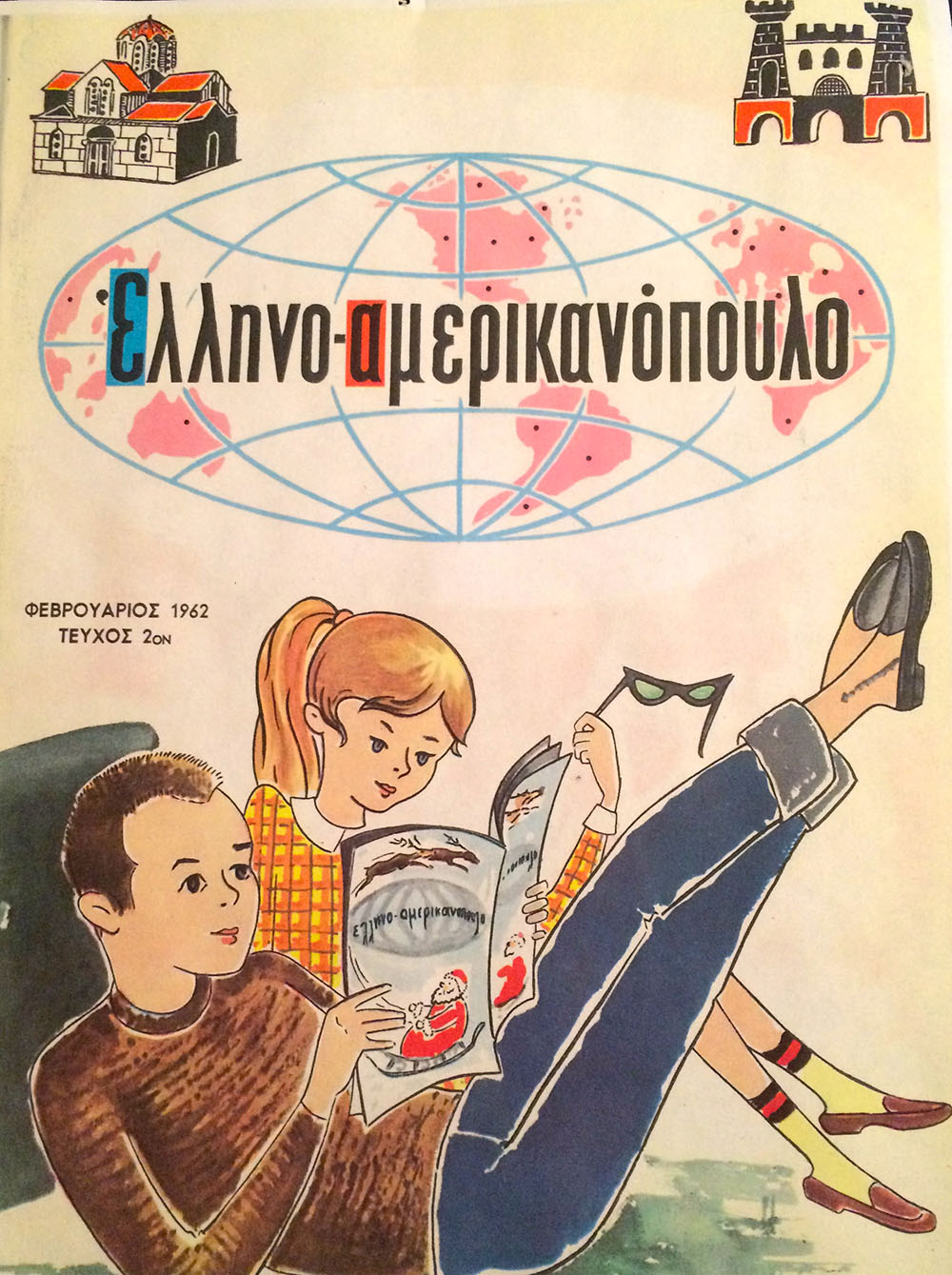
Ellino-Amerikanopoulo (Feb.1962). Greek Orthodox Archdiocese of America, NY, NY.
Pictured above is the vibrant front cover of the Greek-American Magazine for Children [Ellino-Amerikanopoulo], a monthly bilingual children’s magazine created for Greek-American students that circulated across the United States and Canada during the early 1960s.[i] The magazine was supported by the New York City-based Greek Orthodox Archdiocese of North and South America (hereafter Archdiocese), the ecclesiastical administrative body that operated under the jurisdiction of the leader of the Greek Orthodox Church, the Ecumenical Patriarch in Istanbul, Turkey. The publication was edited to reflect the prominence of the Greek Orthodox Church in matters related to education, the immigrant experience, citizenship, and social mobility.
While a small group of Greek merchants made New York City their home in the early to mid-nineteenth century, it was not until the period of heightened immigration between 1880 to 1920 that larger groups settled in New York City and its boroughs. Greek immigrant farmers and craftsmen from rural villages left Greece as a result of government instability and the declining agricultural economy of the south. In New York, they found work as florists, as fruit peddlers, and in shoeshine parlors.[ii] The formal incorporation of the Archdiocese in New York City during this early period aided in the administrative organization of the parish communities and the systematization of Greek education in America. At this time, nearly 25,000 students were being educated in approximately 450 Greek language schools throughout the US.[iii] Greek afternoon and Saturday language schools functioned in every borough of New York City.
When the US was ready to open its doors again to new immigrants through the passage of the Immigration and Nationality Act or Hart-Celler Act of 1965, large numbers of Greek professionals, skilled and unskilled workers, and students seeking higher education made New York City their new home. With this new influx of Greek immigrants, the Archdiocese drew upon its network of community stakeholders to support the expansion of parochial schools in New York, and with the passage of the US Bilingual Education Act of 1968, to advocate for publicly funded Greek language programs in New York City public schools where there were large Greek-speaking student populations in attendance.[iv] By the late 1960s, ten parochial day schools were in operation educating children in grades K-8. Greeks had achieved middle class status as professionals, hoteliers, restaurateurs, importers and exporters, and other small business owners. The number of Greeks living in New York City in 1970 was estimated to be 350,000.[v]
The inaugural volume (January 1962) of the Greek-American Magazine for Children highlighted the intimate relationship between the church and Greek Americans. The magazine was bilingual and served as a bridge for Greek American children. Through articles, stories, and cartoons, the writers connected and reinforced the familiar aspects of Greek ethnic and religious identity as they manifested themselves in the immigrant experience. The publication featured an article that discussed the establishment of the newly constructed parochial school in the Washington Heights section of Manhattan and poems and drawings by the children of St. Andrew’s Academy in Queens, the Greek-American Institute in the Bronx, and St. Eleftherios parochial school in the Chelsea neighborhood. Another article described the weekend religious retreat by the Boy Scouts of America of four New York Greek American communities.[vi]Church communities were central to the social, cultural, and educational activities of Greek Americans. The collaborative efforts between the Archdiocese and community stakeholders ensured that future generations of Greek American children would learn Greek and maintain their ethnic and religious identity.
[i] Ellino-Amerikanopoulo [The Greek-American magazine for children], February 1962, Box V28, Folder FF, Education Collection, Archives of the Greek Orthodox Archdiocese of America, New York, NY.
[ii] Constantine G. Hatzidimitriou, “Greeks,” in The Encyclopedia of New York City, ed. Kenneth T. Jackson (New Haven: Yale University Press, 1995).
[iii] Charles Moskos, Greek Americans: Struggle and Success, (New Brunswick, NJ: Transaction Publishers, 1989), 47.
[iv] Vivian Anemoyanis, “Greek Bilingual Education in Historical Perspective,” in The Greek American Community in Transition, ed. Harry J. Psomiades, Alice Scourby, and John G. Zenelis (New York: Pella Publishing Co., 1982), 171-179.
[v] Hellenic American Neighborhood Action Committee, Inc., The Needs of the Growing Greek-American Community in the City of New York (New York: HANAC, 1973), 13; Eva E. Sandis, “The Greek Population of New York City,” in The Greek American Community in Transition, ed. Harry J. Psomiades, Alice Scourby, and John G. Zenelis (New York: Pella Publishing Co., 1982), 70-73.